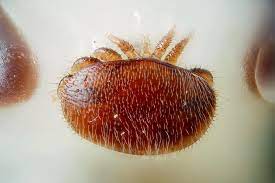Varroa destructor: Difference between revisions
No edit summary |
No edit summary |
||
| Line 28: | Line 28: | ||
[[Image:Male_varroa_destructor.jpg|thumb|right| A male ''Varroa destructor''.]] | [[Image:Male_varroa_destructor.jpg|thumb|right| A male ''Varroa destructor''.]] | ||
==Habitat and Range== | |||
Revision as of 19:20, 9 May 2023
The Varroa mite or Varroa destructor is the world’s most devastating pest of Apis mellifera, the Western honey bee. As ectoparasites, Varroa destructors attack adult honey bees and their developing larvae, feeding on their fat body tissues. Varroa infestation results in deformation, mortality, and subsequent weakening of the colony which potentially leads to colony death. As the mite can spread quickly from colony to colony, the Varroa destructor is an imminent threat to honey bees. Formerly found only in Asia, Europe, Africa, and South America, the mite has now infiltrated the United States where it is devastating the Western honey bee population.
Taxonomy
Kingdom: Animalia
Phylum: Arthropoda
Class: Arachnida
Order: Mesostigmata
Family: Varroidae
Genus: Varroa
Species: Varroa destructor
Description
Adult Varroa destructors measure 1 to 1.8 mm in length and 1.5 to 2 mm in width. Females are reddish-brown in color and males are yellowish-white. The mites have flattened bodies, enabling them to fit between the body segments of honey bees, where they feed on the bee’s fat bodies and internal fluids. Varroa destructors can be observed with the naked eye and may even be observed attached to adult honey bees [1].
Varroa destructor eggs are oval-shaped and white in color. They are approximately 0.30 mm long and 0.23 mm wide. In general, the eggs cannot be seen by the naked eye [2].


